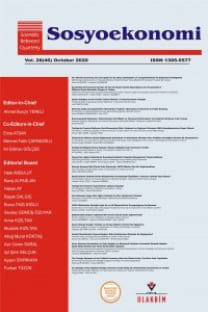Dış Ticaretin Serbestleşmesi ve İşsizlik Arasındaki İlişkinin Heterojen Firma Modeli Çerçevesinde Değerlendirilmesi
Genel Denge Modeli, Etkin Ücret Teorisi, Heterojen Firma Modeli, İşsizlik
Evaluation of the Relationship Between Foreign Trade Liberalization and Unemployment within the Framework of the Heterogeneous Firm Model
General Equilibrium Model, Efficiency Wage Theory, Heterogeneous Firms Model, Unemployment,
___
- Amand, M. & F. Pelgrin (2016), “Pareto Distributions in International Trade: Hard to Identify, Easy to Estimate”, Toulouse School of Economics Macroeconomics Seminar Working Paper.
- Aw, B.Y. et al. (2000), “Productivity and Turnover in the Export Market: Micro-level Evidence from the Republic of Korea and Taiwan (China)”, World Bank Economic Review, 14, 65-90.
- Axtell, R.L. (2001), “Zipf Distribution of U.S. Firm Sizes”, Science, 293, 1818-1820.
- Baldwin R. & P. Krugman (1989), “Persistent Trade Effects of Large Exchange Rate Shocks”, The Quarterly Journal of Economics, 104(4),635-654.
- Baldwin, R. & W. Gu (2003), “Export-Market Participation and Productivity Performance in Canadian Manufacturing”, Canadian Journal of Economics, 36(3),634-657.
- Baldwin, R. (1990), “Hysteresis in Trade”, Empirical Economics, 15(2), 127-142.
- Bentivogli, C. & P. Pagano (1999), “Trade, Job Destruction and Job Creation in European Manufacturing”, Open Economies Review, 10, 165-184.
- Bernard, A. et al. (2007), “Firms in International Trade”, Journal of Economic Perspectives, 21(3), 105-130.
- Bernard, A.B. & J.B. Jensen (1999), “Exceptional Exporter Performance: Cause, Effect, or Both?”, Journal of International Economics, 47, 1-25.
- Bernard, A.B. et al. (2003), “Plants and Productivity in International Trade”, American Economic Review, 93(4), 1268-1290.
- Brecher, R.A. (1974), “Minimum Wage Rates and the Pure Theory of International Trade”, The Quarterly Journal of Economics, 88(1),98-116.
- Caliendo, L. et al. (2019), “Trade And Labor Market Dynamics: General Equilibrium Analysis of The China Trade Shock”, Econometrica, 87(3), 741-835.
- Clerides, S.K. et al. (1998), “Is Learning by Exporting Important? Micro-dynamic Evidence fromColombia, Mexico, and Morocco”, The Quarterly Journal of Economics, 113, 903-947.
- Cote, S.L. (2007), “Tariff reduction and employment in Canadian manufacturing”, Canadian Journal of Economics, 40(3), 843-860.
- Dutt, P. et al. (2009), “International trade and unemployment: Theory and Cross-National Evidence”, Journal of International Economics, 78, 32-44.
- Egger, H. & U. Kreickemeier (2009), “Firm Heterogeneity and the Labor Market Effects of Trade Liberalization”, International Economic Review, 50(1), 87-216.
- Fugazza, M. & A.C. Molina (2009), “The Determinants of Trade Survival”, HEID Working Paper, No:05/2009, 1-37.
- Helpman, E. & O. Itshoki (2010), “Labor Market Rigidities, Trade and Unemployment”, Review of Economic Studies, 77(3), 1100-1137.
- Helpman, E. et al. (2004), “Export versus FDI with Heterogeneous Firms”, American Economic Review, 94(1), 300-16.
- Hung, L.W. & S.K. Peng (2019), “Unemployment With Trade And Firm Heterogeneity”, International Journal of Economic Theory, 16(1), 62-81.
- Janiak, A. (2007), “Does Trade Liberalization Lead to Unemployment? Theory and Some Evidence”, Mimeo, Universite Libre de Bruxelles Thesis, 1-50.
- Krugman, P. (1980), “Scale Economies, Product Differentiation, and the Pattern of Trade”, The American Economic Review, 70(5), 950-959.
- Lee, K.Y. (2018), “A Quantitative Trade Model with Unemployment”, Korea Institute for International Economic Policy Working Papper, No:18-04.
- Mas-Colell, A. et al. (1995), Microeconomic Theory, New York: Oxford University Press.
- Matusz, S.J. (1986), “Implicit Contracts, Unemployment and International Trade”, The Economic Journal, 96(382), 307-322.
- Melitz, M.J. & S.J. Redding (2012), “Heterogeneous Firms and Trade”, Center for Economic Performans Discussion Paper, No.1183, 1-66.
- Melitz, M.J. (2003), “The Impact of Trade on Intra-Industry Reallocations and Aggregate Industry Productivity”, Econometrica, 71, 1695-1725.
- Melitz, M.J. (2008), “International Trade and Heterogeneous Firms”, içinde: S.N. Durlauf (ed.), New Palgrave Dictionary of Economics Second Edition, New York: Palgrave Macmillan.
- Pişkin, E. (2017), “Türkiye İhracatının Ölüm-Kalım Meselesi”, Munich Personal RePEc Archive, No. 81459.
- Saez, E. (2001), “Using Elasticities to Derive Optimal Income Tax Rates”, Review of Economic Studies, 68, 205-229.
- ISSN: 1305-5577
- Yayın Aralığı: Yılda 4 Sayı
- Başlangıç: 2005
- Yayıncı: Sosyoekonomi Derneği
Beyza GÜLTEKİN, S. Ihsan KİLİC
Bhagwati Tarafından Önerilen Beyin Göçü Vergisinin Uygulanabilirliğinin Analizi
Bilgi-İletişim Teknolojileri (BİT) ve Hava Kirliliğinin Sağlık Harcamalarına Etkisi
Cuma DEMİRTAŞ, Munise ILIKKAN ÖZGÜR
İnovasyonun İstihdam Düzeyine Etkisi: Türkiye İçin Bir ARDL Sınır Testi Yaklaşımı
Merkez Bankası Faiz Duyurularının Borsa İstanbul Turizm Endeksi Getirilerine Etkisinin Analizi
Fatih GÜNAY, Engin BAYRAKTAROĞLU
Kriptopara Bağlantılılığı ve COVID-19: Diebold-Yılmaz ve Frekans Bağlantılılığı Yöntemleri
İntihar Olgusunu Sosyal ve Ekonomik Açıdan İncelemek Mümkün Mü?
Gözde BOZKURT, Volkan ÖNGEL, Ayşe GÜNSEL
Zeynep ÇİRKİN BÜYÜKDENİZ, Türkmen GÖKSEL
Canan SANCAR, Yusuf Ekrem AKBAŞ
Türkiye’de İyi ve Kötü İşler: Genç Çalışanlar Üzerinden Bir Analiz
